Hinduism
has the 3rd
largest following among religions in the world and is one of the
oldest too dating back to 1500 BC.
Temples
including Kailash Nath, Madhuri Meenakshi, Somnath, Jagannath, Ajanta
and Ellora Caves, are among prime examples of Hindu craftmanship that
have stood the test of time.
While India was famous for its temples and artistic carvings, it was only in the 1800’s that Hindu art and paintings started making waves in the international scene.
In this piece, we explore ten famous
pieces of Indian art that have managed to mesmerizeus even today.
1. Mahalakshmi by Raja Ravi Verma
 Source: https://www.artzolo.com/painting/goddess-lakshmi?id=8354
Source: https://www.artzolo.com/painting/goddess-lakshmi?id=8354
In this painting by one of India’s greatest painters Raja Ravi Verma, the goddess of wealth and fortune Mahalakshmi is depicted to be standing on a lotus floating gently on a beautiful pond with swans and an elephant in the backdrop.
If
you observe closely, Mahalakshmi despite being the goddess of wealth
is clad in simple attire, just like any other human being. There is
not as much as a hint of exuberant jewellery or precious stones
adorning her body.
Ravi Verma’s perception of wealth was quite different from conventional ideas and it implies that wealth is not something that holds significance in the physical form and it means much more than that.
2. Saraswati by Raja Ravi Verma
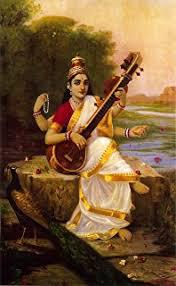 Source:
https://www.artzolo.com/painting/goddess-saraswathi
Source:
https://www.artzolo.com/painting/goddess-saraswathi
The
goddess of knowledge, Saraswati, in this piece of art is draped in a
white saree, depicting purity, and is sitting beside a river playing
the Veena. The Veena represents knowledge, which again is
unconventional. The river in the backdrop symbolizes flow of
knowledge in humans and its journey towards an ocean where it
accumulates in the way that every other idea in the world is brought
together.
3. Shakuntala by Raja Ravi Verma
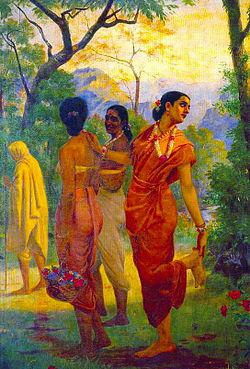 Source:https://www.artzolo.com/painting/shakumthala-looks-love
Source:https://www.artzolo.com/painting/shakumthala-looks-love
Not only has
Raja Ravi Verma immortalized gods and goddesses but also many
prominent figures in Hindu tradition. This painting depicts an
important character Shakuntala from the epic Mahabharata. She is the
wife of Dushyanta and the mother of emperor Bharat. Ravi Verma
painted different pieces based on different plots of the whole story
and the above piece of art depicts a very young Shakuntala. She has
already fallen in love with the prince Dushyanta, and is turning
around to steal a glance at him with an excuse of picking a thorn
from her feet whilst taking support of her friend. The genius of Ravi
Verma beautifully captures the playfulness of youth in this painting.
4. Jatayu Vadham by Raja Ravi Verma
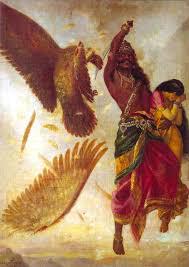 Source:
http://artpaintingartist.org/jatayu-vadham-by-raja-ravi-varma/
Source:
http://artpaintingartist.org/jatayu-vadham-by-raja-ravi-varma/
Another Ravi Verma painting makes it to the list and this time, it is from the Ramayana. Jatayu, a demigod in vulture’s form is a loyalist of Lord Ramaand is trying to prevent Ravana from abducting Sita. However, he proves to be unsuccessful and is gravely hurt by Ravana. He falls on the ground while Ravana escapes with Sita. This picture depicts a ferocious Ravana and an equally ferocious Jatayu right before the last moment of the fight.
5. Krishna and Balarama by Jamini Roy
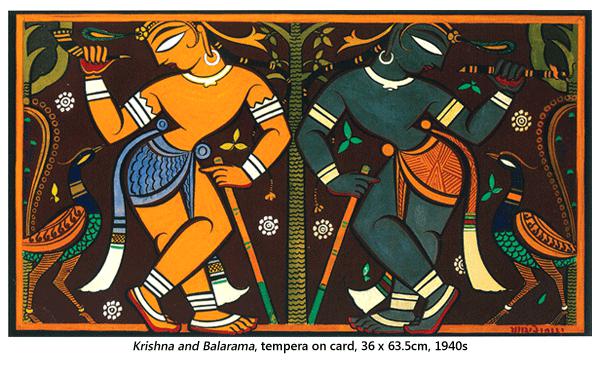 Credits: http://www.artnewsnviews.com/view-article.php?article=jamini-roy-s-art-in-retrospect&iid=22&articleid=559
Credits: http://www.artnewsnviews.com/view-article.php?article=jamini-roy-s-art-in-retrospect&iid=22&articleid=559
This painting by the renowned artist Jamini Roy depicts the two brothers Krishna and Balarama. Krishna is depicted in grey whereas Balarama is depicted in a darker hue of yellow. The painting is drawn in a symmetrical fashion which seems to showcasethe fact that the brothers were projections of each other’s image. Jamini Roy has made use of earthly colours in a very exuberant fashion in this painting.
6. Krishna, spring in Kullu by Nicholas Roerich
 Source: https://www.wikiart.org/en/nicholas-roerich/krishna-spring-in-kulu-1930
Source: https://www.wikiart.org/en/nicholas-roerich/krishna-spring-in-kulu-1930
Hinduism’s spread was not confined to the Indian subcontinent and had its reach far beyond the peaks of the Himalayas. The Russian writer and artist Nicholas Roerich, who lived the last of his days in the Kullu valley, seems to have been influenced by the philosophical depiction of human nature in the form of Krishna. In the above painting, he has depicted Krishna playing the flute with a backdrop of the snow-covered peaks. A mild breeze is blowing in the background which can be witnessed by the movement of the branches. Unlike common depictions of Krishna, Roerich, here has depicted him with a normal skin colour unlike the conventional dark blue.
7. Mahisasura by Tyeb Mehta
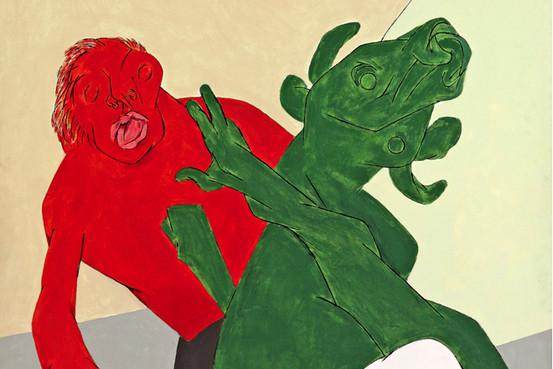 Source:http://www.bbc.com/news/world-asia-india-18407449
Source:http://www.bbc.com/news/world-asia-india-18407449
This 1996 painting was sold for $2.2 million at Christie’s auction in 2012 and is a source of inspiration for modern day Indian artists. It depicts the fall of the buffalo demon Mahisasurain in a ferocious fight with the goddess Durga. Tyeb Mehta’s art signifies equality and shows that a female is no less compared to a male when it comes to sheer physical strength. The defeat of Mahisasura earned Durga the renowned name ‘Mahisasuramardini’ which means the destroyer of Mahisasura.
8. Yasoda with Krishna by Raja Ravi Verma
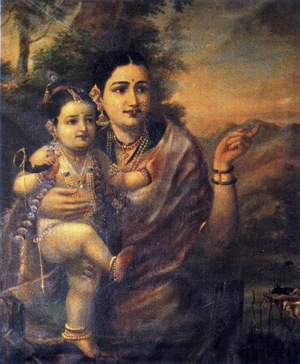 Source:https://www.artzolo.com/painting/yasoda-krishna
Source:https://www.artzolo.com/painting/yasoda-krishna
Raja Ravi Verma’s best works were often see in his oil paintings and this stunning piece of art depicts the bonding between Yasoda and Krishna. The sunrays falling on the fragile body of Lord Krishna as he stares into the distance where his mother is pointing is simply beautiful and captures the innocence of childhood its entirety.
9. Tanjore Painting:
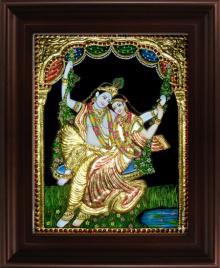 Source:
https://www.artzolo.com/traditional-art/swinging-radha-krishna-tanjore-2
Source:
https://www.artzolo.com/traditional-art/swinging-radha-krishna-tanjore-2
No one specific work
of art makes it to our list here because it is simply too hard to
choose. Tanjore
paintings as the name suggests, originated in the south Indian
state of Tamil Nadu, in a town named Tanjore. This style of art dates
back to the 9th
century A. D. It flourished under the Chola rulers.
The paintings are well known for their elegance, rich colours and attention to detail. These paintings are also famous for the various jewellery embedded in them, which primarily consists of semi-precious stones and gold foils which make them look grand.
10. RAJPUT PAINTING
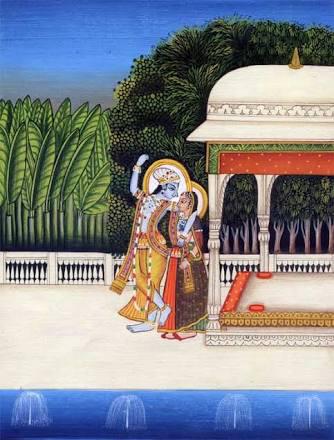 Source:http://blog.artoflegendindia.com/2010/12/rajput-paintings-splendour-of-rajashtan.html
Source:http://blog.artoflegendindia.com/2010/12/rajput-paintings-splendour-of-rajashtan.html
Rajput painting
originated in the 18th century, in the royal courts of Rajputana, Rajasthan, India. These paintings depicted a number of themes and events from the epics like Ramayana and Mahabharata and also excerpts from Krishna’s life.
The colours used
in these paintings were extracted from certain minerals, plant
sources, and conch shells and were derived by processing precious
stones, gold and silver.
The preparations of colours was a
lengthy process, but the by-products of hard labour are the various
beautiful Rajput paintings that now exist.
Author
is founder and CEO of Artzolo.com, an online marketplace for emerging
and professional artists.
Also see
1. Albums of Traditional Paintings of India
2. Warli and Madhubani Paintings